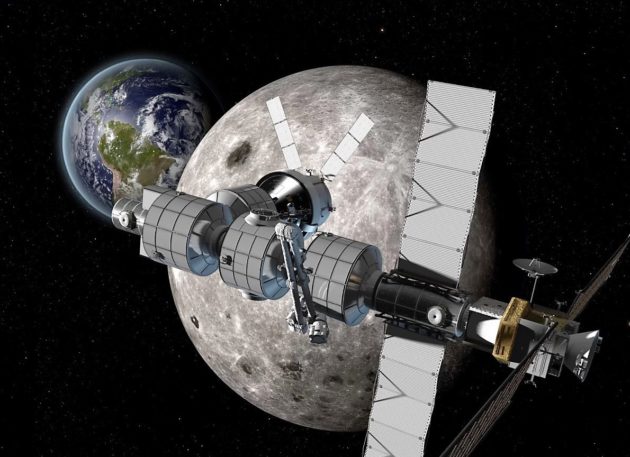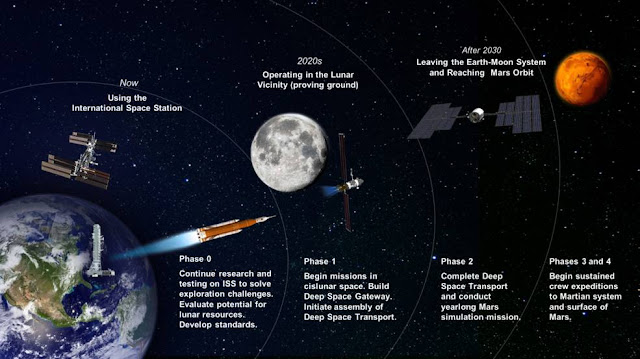 |
| Artist's depiction of NASA's planned Lunar Orbital Platform-Gateway. (Credit: NASA). |
NASA's plans for further space exploration currently include "Gateways." Such Gateways are planned for the moon (Earth's moon) and later for Mars. Exactly what these Gateways will look like and what they will do continues to be revealed now and then.
 |
| Boeing's plan for the Lunar Gateway (Credit: Boeing). |
The federal fiscal year 2019 budget calls for the first pieces of the moon's gateway to be launched in 2022 (NASA early in 2018 optimistically predicted this would happen by the fiscal year 2020, but that now appears unrealistic). Since it's not built yet, the moon's Gateway - called the Lunar Orbital Platform-Gateway - is still being finalized. As usual with NASA, there will be "international cooperation," but exactly what that means is unclear. There have been mixed signals from Russia about participating in the Gateway project, but Russia definitely seems interested in the moon itself. The Lunar Gateway won't be completed and ready for full use until 2025 under the most optimistic scenarios, though the first crewed mission could take place by 2023. The Lunar Gateway would be launched by the Space Launch System (SLS) and Orion spacecraft. Exactly what role SpaceX and other private ventures would play in the Gateway is unclear.
 |
| The Gateway would serve as a docking port for missions to the moon and, later, Mars. (Credit: Nathan Koga / SpaceFlight Insider). |
NASA's 2 May 2018 statement read:
As reflected in NASA's Exploration Campaign, the next step in human spaceflight is the establishment of U.S. preeminence in cislunar space through the operations and the deployment of a U.S.-led Lunar Orbital Platform-Gateway. Together with the Space Launch System (SLS) and Orion, the gateway is central to advancing and sustaining human space exploration goals, and is the unifying single stepping off point in our architecture for human cislunar operations, lunar surface access and missions to Mars. The gateway is necessary to achieving the ambitious exploration campaign goals set forth by Space Policy Directive 1. Through partnerships both domestic and international, NASA will bring innovation and new approaches to the advancement of these U.S. human spaceflight goals.NASA administrator Jim Bridenstine - confirmed by the US Senate in April 2018 - wants Gateways around the moon and Mars and maybe elsewhere. The current plan for the Lunar Gateway is to place it in a near-rectilinear halo orbit. This is best for minimizing energy needs on the Gateway. In addition, it won't be permanently manned like the International Space Station. Instead, it would serve as a sort of temporary hotel room for astronauts traveling to the moon for different purposes. The missions would be for 30- to 60-day periods
 |
| An old roadmap which portrayed the earth's moon as merely a preliminary stop on a Mars mission appears to be outdated now. The moon itself now is the objective. |
As for the Mars Gateway, that's a little further off. Bridenstine describes it as a "deep-space transport" which would be ready perhaps around 2030. All plans are subject to change and refinement, of course, with NASA's budget the main factor on when everything happens. This current Gateway concept, however, outlines the current roadmap.
2018